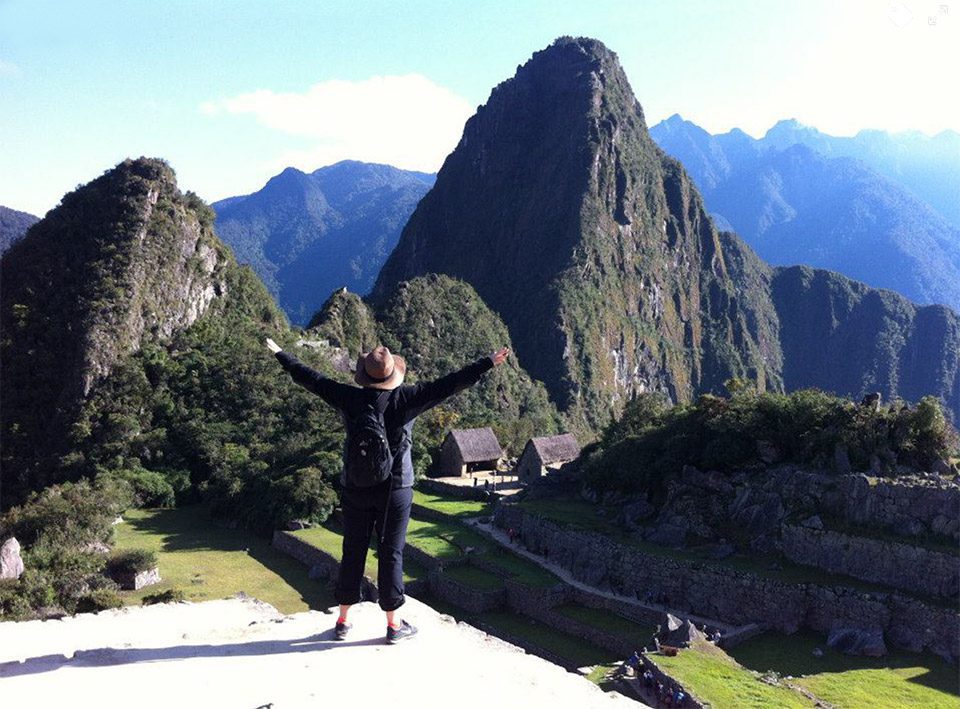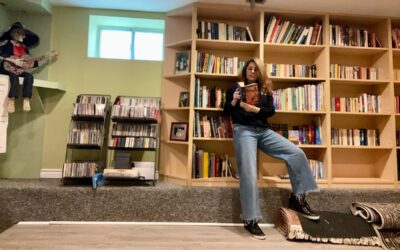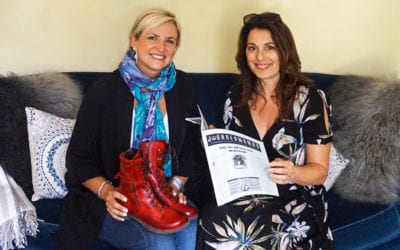Last updated on January 29th, 2024
Featured image: It’s never too late to follow your dreams/ Photo credit RPBaiao on Shutterstock
Women who follow their dreams to travel
by Carolyn Ray
When my daughter left home for university three years ago, I decided to make a major lifestyle change. She and I had just returned from a transformative trip to Kenya, and I felt an overwhelming desire to simplify my life. After almost 30 years working a full-time job, paying a mortgage and commuting three hours a day, I decided it was time for something new. I wanted to be free. I didn’t want to be constrained by my material possessions. It was finally my time to follow my dream and start a new journey of downsizing for travel in midlife.
I put my three-bedroom suburban house on the market. When it sold, I had less than four weeks to move out. Reality struck. I had lived in this particular house for almost 15 years. I had never cleared anything out. I remember looking at it all and wondering ‘how I am going to do this?’ It felt insurmountable. I was mortified with the things I had accumulated in 25 years. I decided it was time to get rid of it all.
Women who have downsized in their 50s
When I shared my story, I learned that many women have also downsized to travel, for different reasons. My reason was a desire to reinvent my life and start on a new path. For Christine Pope, it was about following her dreams to backpack around the world. For Kate Savory, it was the result of a divorce.
When Pope was in her early 50s, she dreamed of backpacking around the world. She told her friends in Toronto to ‘come and get it’ and put her remaining belongings in three or four boxes. Stopping briefly in Nova Scotia to see her sister, she took her backpack and headed for San Miguel de Allende, Mexico, a small town about four hours northwest of Mexico City. That was almost three years ago.
“My plan was always to go out the door with my backpack,” Pope says. “I wanted to live simply. I didn’t want to own anything I had to dust, like china or figurines.” Mexico was familiar to her; she had backpacked extensively there for about 10 years.
Read More: How to Downsize for Travel: Expert Tips

After her divorce, Kate found solace in travel and sailing the seas with other singles / Photo credit: NDABCREATIVITY on Adobe Stock
Downsizing after divorce
After her divorce at age 50, Kate Savory decided to reshape her life. She sold her house in Seattle and downsized the possessions that she had spent her life accumulating.
“I felt lighter,” she said. “But it was bittersweet: I recognized that this was not my life anymore and I had to let go of it.”
Kate downsized with the help of her sister and daughter. “Once I started, it was exciting. I was freeing up space in my body.”
One of the biggest challenges for Kate was reducing family heirlooms. Eventually, she came to terms with it. “It’s just stuff,” she says. Kate picked out five treasured teacups for family and sold the rest. “Every month, my daughter and I have a virtual teatime. It’s a special moment where we acknowledge the past and revisit special memories.”
The rest of her heirlooms she put in storage, but after a few years, she downsized that too. “I paid for storage for years to hold things I never used. I got rid of the storage four years ago and haven’t looked back.”
Most winters, Kate goes to Mexico to housesit. Due to the pandemic, she recently purchased a small 610 square foot apartment as her home base until it’s safe to travel again.
“But I’m ready to go, she says. “Lock and leave, come and go – that’s the plan.”
Finding affordable accommodations
Pope’s biggest challenge when she arrived in Mexico was finding affordable accommodation and a job that would allow her to save up until her pension kicked in. Through a friend, she joined different community groups and eventually found a job doing homecare that offered her free accommodation. Over time, she found a job with a recruitment and executive coaching firm, where she works today.
Today, Pope is backpacking all over Mexico, just having recently visited the Sierra Chincua Butterfly Reserve to see the migration of monarch butterflies. She also visited the “Christmas Town”, Tlalpujahan, where they make Christmas ornaments.
Savory started her new life by looking for housesitting opportunities in places that appealed to her. Her first housesitting was in Hawaii, followed by Mexico. She also pursued two of her passions: sailing and travel. She joined a group called the Seattle Singles Yacht Club and begin travelling with a group of people to places around the world for weeks at a time. In the past few years, she has travelled to Italy, Belgium, Spain, Croatia, the British Virgin Islands and Thailand with her sailing club.
Photo provided by Christine P.
Lessons learned from downsizing
One of the benefits of downsizing is that there is less spending on things you don’t absolutely need. There simply isn’t room for new things, unless the old items are donated. Instead of shopping, there is time to spend with family and friends.
Pope wishes she had downsized in her 20s, not her 50s. “If I had to do it over again, I’d take the chance and go earlier. I didn’t have a house, kids, husband.” If you’re planning to spend time in another country and need to support yourself, her advice is to: “Figure out something to earn income. Learn a transferrable skill, and go!”
She does have some things she kept: “My treasured items include my grandmother’s St. Christopher medal, a ribbon blessed by a Buddhist monk, the book Nothing to Declare by Mary Morris, some photos, passport, some different currencies, a treasured ring and a half-marathon medal.”
Learning to live with less
Pope says she has learned to live with very little; her wardrobe is a reflection of this philosophy.
“I have black t-shirts and five sweaters that I freshen up with scarves, two pairs of jeans and a pair of yoga pants,” she says. “When I need something, I go to a flea market. This allows me to put money back into the local community.”
Savory’s advice is to save the things that bring you comfort. Keep practical things, like a small table or chairs, that you can incorporate into a smaller space. “Don’t think about what you’ve given up, rather, challenge yourself to look ahead,” she advises.
Read More: Learn how Kate travels full time here
What’s Next
Downsizing is an ongoing journey, starting with having a vision for your future. This makes it not just an organizational process, but an emotional one. Whether you’re donating, auctioning or giving away your precious possessions, there will be a moment when you wonder if it’s all worth it. It is, and once you’ve found the freedom that comes with having less, you will wonder why you didn’t do it sooner.
More Midlife Reinvention to Inspire You
Decluttering in Midlife: Erica Ehm Makes Space for Her Next Chapter
Erica Ehm has found that decluttering can help clear space, both emotionally and physically, for the next chapter of our lives.
Never Too Late: Bestselling Women Authors Over 50
Ten exceptional women authors over 50 who prove that experience and mature reflection is welcomed, showing us it’s never too late to publish.
Why It’s Never Too Late: Reinvention at Any Age
It’s never too late to embrace reinvention at any age, as travel writer Leyla Alyanak, 70, is still discovering as she looks for new adventures.













I love the gold lamé dress – I’m actually looking for one right now lol!
People can also consider donating to the Habitat for Humanity ReStore in their area. In the Spring I donated a dining table that was now too large for my needs. They came and picked it up and send me a tax receipt for more than I expected.
A very interesting article but I’d thought it was going to be about what to take when travelling! I’m sure you’ve already done that and if you have could you please forward it to me? I’d also be interested in any articles/tips you have on housesitting, if you have any! Not everyone has lots of money!! I live in the UK and I wonder if you have other readers who live here. Thanks.
Hi Sarah! Well, we have to start with the basics! More is planned on housesitting, homestaying and other topics! Thank you for your feedback!
Excellent article with some pointers I’d never have thought of. I was locked down in South Africa for almost 9 months in 2020. Living in an large tent in a wilderness reserve, I discovered that I could survive quite nicely with the contents of 1 suitcase & a carry-on. I did borrow a few warm items as I was unprepared for their winter and a friend of the reserve owner lent me a sewing machine so I had things to do. When I finally returned home I was overwhelmed by all the stuff I had accumulated (in spite of a drastic downsize in 2007) that needed to be sorted, cared for and I didn’t really need (or want?). I will definitely be referring back to this article.